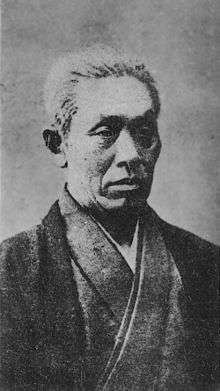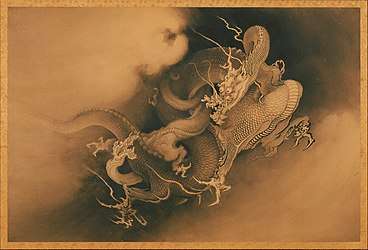Kanō Hōgai
Kanō Hōgai (狩野芳崖, February 27, 1828 – November 5, 1888) was a Meiji era (19th-century) Japanese artist of the Kanō school. As one of the last Kanō artists, he helped pioneer the nihonga art style with Hashimoto Gahō and art critic Ernest Fenollosa. Hōgai's work reflected the traditional style of the school whilst still showing experimentation and influence with Western methods. Hōgai is perhaps best known for his paintings of dragons, birds, and Buddhist gods such as Kannon (also known as Guanyin).
Kanō Hōgai | |
|---|---|
狩野芳崖 (かのう.ほうがい) | |
 Kanō Hōgai | |
| Born | February 27, 1828 Chōfu Domain in modern day Yamaguchi Prefecture |
| Died | October 5, 1888 (aged 60) |
The son of the local daimyō's chief painter, he was sent at the age of 18 to Edo to study painting formally. He stayed there for ten years and studied under Kanō Shōsen'in and other prominent artists of the time. Hōgai would eventually be called upon for such esteemed commissions as ceiling paintings for Edo Castle. He also received the honor of having some of his works displayed at the 1876 Paris International Exposition.

However, despite these honors, the economic turmoil created by the fall of the shogunate in 1868 forced Hōgai to seek to support himself with income via more mundane methods. He worked at casting iron, reclaiming land, and running a shop selling writing instruments. In 1877 Hōgai returned to Edo, now called Tokyo, and worked for the wealthy Shimazu clan; this gave him the opportunity to study works by some of Japan's greatest painting masters, including Sesshū and Sesson.
In 1884, Hōgai attracted the attention of Ernest Fenollosa, an art critic and collector from New England, who befriended him and bought several of his paintings. Along with Fenollosa, Okakura Kakuzō and Hashimoto Gahō, Hōgai then took part in the Painting Appreciation Society (観画会, Kangakai). The Society was created to draw attention to the traditional Japanese arts, particularly classical art of the Heian and Nara periods which were beginning to be seriously neglected, with many works sold or even destroyed due to Japan's newfound interest in the West.
_Original_on_Silk_Scroll.jpg)
Gallery
 Two Dragons (In Clouds); Meiji Era, c. 1885. Ink on paper, framed. w135.3 × h90.2 cm.[4] Philadelphia Museum of Art
Two Dragons (In Clouds); Meiji Era, c. 1885. Ink on paper, framed. w135.3 × h90.2 cm.[4] Philadelphia Museum of Art Hawks in a Ravine; Meiji Era, c. 1885. Ink on paper, h165.7 × w93.2 cm [5]. Boston Museum of Fine Arts
Hawks in a Ravine; Meiji Era, c. 1885. Ink on paper, h165.7 × w93.2 cm [5]. Boston Museum of Fine Arts- Lions; Meiji Era, c. 1886. Ink on paper. w49.5 × h98.3 cm.[6][7] National Museum of Modern Art, Tokyo
_Original_on_Silk_Scroll.jpg) Hibo Kannon (悲母観音); Meiji Era, 1883. Ink, color and gold on silk. w84.6 × h163.9 cm.[8][9] Freer Gallery of Art
Hibo Kannon (悲母観音); Meiji Era, 1883. Ink, color and gold on silk. w84.6 × h163.9 cm.[8][9] Freer Gallery of Art.jpg) Dragons Ascending the Heavens (飛龍昇天); Meiji Era, c. 1887; Panel, ink on paper. w62.4 × h137.9 cm.[10] Museum of Fine Arts, Boston
Dragons Ascending the Heavens (飛龍昇天); Meiji Era, c. 1887; Panel, ink on paper. w62.4 × h137.9 cm.[10] Museum of Fine Arts, Boston
References
- "Philadelphia Museum of Art - Collections Object : Two Dragons (in Clouds)". www.philamuseum.org. Retrieved 2019-07-04.
- "Hibo Kannon - Artist: Kano Hogai". Google Arts & Culture. Retrieved 2019-07-05.
- "Hibo Kannon". Freer|Sackler. Retrieved 2019-07-05.
- "Philadelphia Museum of Art - Collections Object : Two Dragons (in Clouds)". www.philamuseum.org. Retrieved 2019-07-04.
- "Hawks in a Ravine". Museum of Fine Arts Boston. Museum of Fine Arts, Boston: Museum of Fine Arts Boston. Retrieved 4 July 2019.
- "Lions - KANO, Hogai". Google Arts & Culture. Retrieved 2019-07-04.
- "独立行政法人国立美術館・所蔵作品検索". search.artmuseums.go.jp. Retrieved 2019-07-04.
- "Hibo Kannon - Artist: Kano Hogai". Google Arts & Culture. Retrieved 2019-07-05.
- "Hibo Kannon". Freer|Sackler. Retrieved 2019-07-05.
- "Dragon Ascending the Heavens". collections.mfa.org. Retrieved 2019-07-05.
- Baekeland, Frederick (1985). "Kanō Hōgai." Kodansha Encyclopedia of Japan. Tokyo: Kodansha Ltd.